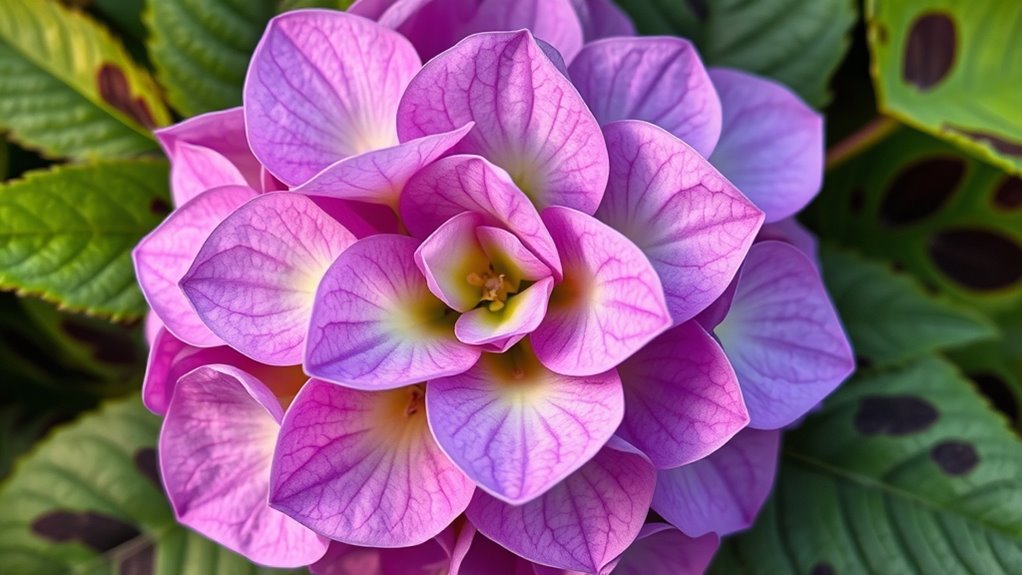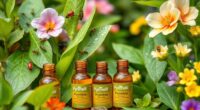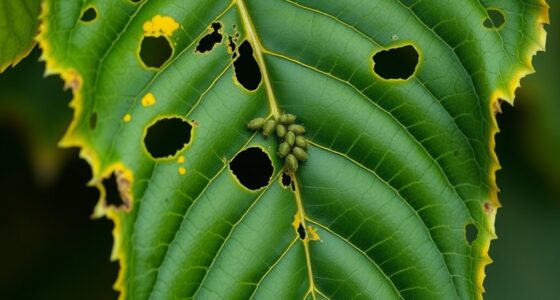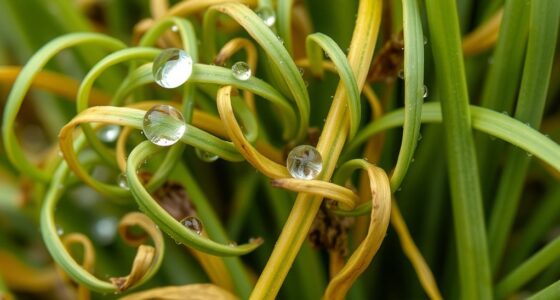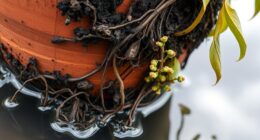If your Hydrangea Glam Rock is losing color and developing leaf spots, it’s likely due to soil pH changes, improper fertilizing, or pests. Balance soil acidity and use the right fertilizer to keep blooms vibrant. Regularly remove affected leaves and improve air circulation to prevent fungal leaf spots. Consistent watering, pruning, and pest control are key to healthy, colorful plants. Keep exploring for tips to boost your plant’s health and beauty.
Key Takeaways
- Color fading often results from soil pH imbalance, improper fertilization, or nitrogen overuse.
- Leaf spots are caused by fungal infections, humid conditions, or nutrient deficiencies like magnesium or iron.
- Regular inspection, pruning, and removing affected leaves help prevent disease spread and improve plant health.
- Maintaining proper soil pH, consistent watering, and mulching support vibrant blooms and overall vitality.
- Use balanced fertilizers, improve air circulation, and treat pests early to prevent color loss and leaf spot issues.
Understanding the Causes of Color Fading in Hydrangea Glam Rock

Color fading in Hydrangea Glam Rock occurs primarily because of changes in soil pH and nutrient availability. When soil becomes too acidic or alkaline, it affects the flower’s vibrant hue. Proper fertilizer selection is vital; using a balanced or color-specific fertilizer helps maintain consistent color. Over-fertilizing with high nitrogen can promote lush foliage but may dull flower color, so adjust accordingly. Pest control is also essential, as pests like aphids and spider mites can weaken the plant and interfere with nutrient absorption, leading to color loss. Regular inspection and treatment keep your hydrangea healthy and guarantee it retains its striking appearance. Additionally, understanding the soil composition and its impact on plant health can help you make informed decisions about amendments and care. Monitoring soil pH levels regularly ensures you can make timely adjustments to preserve vibrant blooms. By managing soil pH, choosing the right fertilizer, and controlling pests, you help preserve the stunning color of your Hydrangea Glam Rock. Maintaining proper soil nutrients also supports overall plant vigor and helps prevent color fading.
Identifying and Managing Leaf Spot Issues
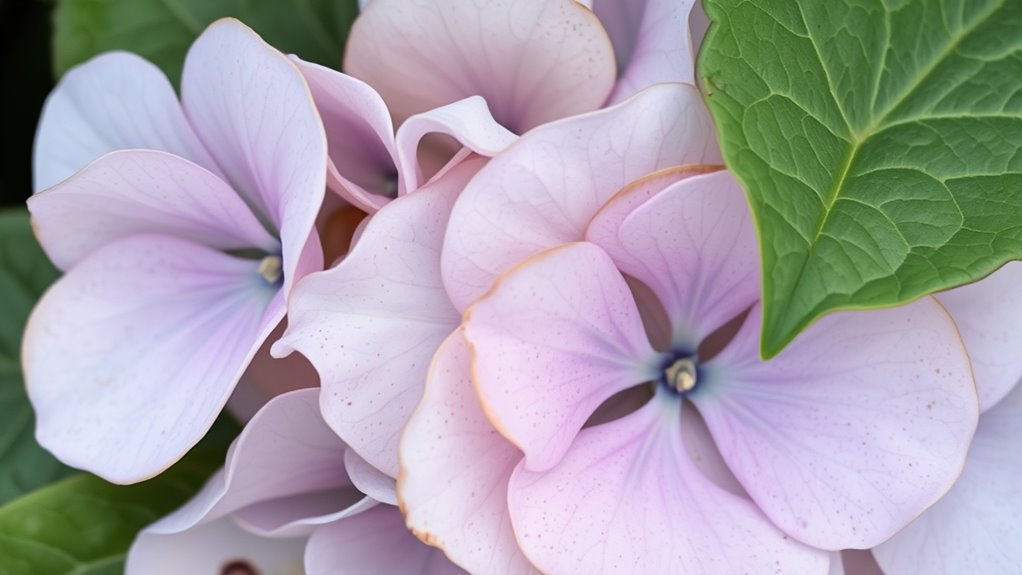
While maintaining soil health and proper fertilization is key to vibrant hydrangea blooms, you also need to watch for common leaf issues that can threaten the plant’s overall health. Leaf spot problems often stem from fungal infections, which cause dark, irregular spots on the foliage. These spots can spread quickly in humid conditions, leading to leaf drop and weakened plants. Nutrient deficiencies, especially of magnesium or iron, may also cause discoloration or spotting, making leaves look unhealthy. To identify leaf spot issues, regularly inspect your hydrangea’s leaves for signs of fungal growth or unusual spots. Manage these problems by removing affected leaves, improving air circulation, and applying appropriate fungicides if necessary. Ensuring proper nutrition can also help bolster your plant’s defenses against leaf diseases. Additionally, selecting appropriate plant varieties that are resistant to common pests and diseases can help prevent future issues.
Best Practices for Maintaining Vibrant Blooms

To keep your hydrangeas producing vibrant, eye-catching blooms, it’s essential to follow specific care practices that promote healthy flowering. Regular pest control helps prevent insects that can damage buds and flowers, ensuring your hydrangeas stay healthy and bloom generously. Incorporate proper pruning techniques by removing dead or weak stems after flowering; this encourages new growth and promotes larger, more vibrant blooms. Use clean, sharp tools to make precise cuts, reducing the risk of disease. Avoid over-pruning, which can stress the plant and diminish flowering potential. Ensuring good airflow around your hydrangeas also minimizes pest and disease issues. Regularly monitoring plant health metrics helps you catch potential problems early and maintain optimal growth conditions. Staying consistent with pest control and pruning practices helps your hydrangeas maintain their color, size, and overall vibrancy throughout the season. Additionally, understanding the soil pH requirements for hydrangeas can significantly influence their bloom color and overall health, especially as soil acidity impacts flower hue.
Soil and Watering Tips to Support Healthy Growth

Healthy soil and proper watering are the foundation of vibrant hydrangea blooms. To support healthy growth, focus on maintaining the right soil pH through pH adjustment, ensuring nutrients are accessible. Consistent watering keeps roots moist but not waterlogged, which prevents leaf spots and color fade. Mulching techniques help retain soil moisture, regulate temperature, and suppress weeds, promoting overall plant health. Incorporating glycolic acid treatments can also improve the skin’s appearance around hydrangeas, especially for gardeners who want healthy, glowing skin while tending to their plants.
Preventative Measures and Treatment Solutions
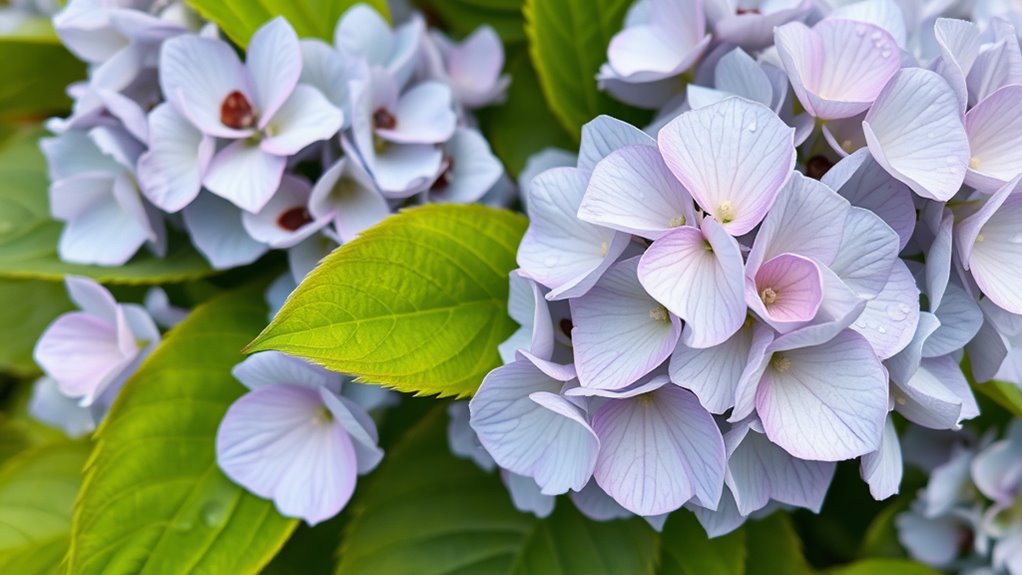
Implementing preventative measures is essential to keep hydrangeas healthy and minimize the risk of problems. Start with proper pruning techniques to remove dead or weak stems, improve air circulation, and promote strong growth. Pruning at the right time helps prevent leaf spot and reduces disease spread. When it comes to fertilizer choices, opt for balanced, slow-release formulas that provide essential nutrients without overfeeding. Avoid high-nitrogen fertilizers, as they can lead to excessive foliage growth and color fading. Regularly inspect your hydrangeas for early signs of trouble, and promptly address issues like spots or discoloration. By maintaining good garden hygiene, pruning correctly, and choosing appropriate fertilizers, you set a strong foundation for resilient, vibrant hydrangeas with minimal problems.
Frequently Asked Questions
Can Hydrangea Glam Rock Thrive in Full Shade?
You might wonder if Hydrangea Glam Rock can thrive in full shade. While it prefers partial sun, it’s somewhat shade-tolerant, though full shade could result in fewer blooms. To guarantee healthy growth, provide well-draining soil with the right soil requirements, and monitor the plant’s shade tolerance. Keep in mind, too much shade may reduce vibrant color, but with proper care, your hydrangea can still flourish.
What Are Natural Remedies for Leaf Spot?
You can manage leaf spot on your hydrangea glam rock with natural remedies by focusing on organic treatments and disease prevention. Remove and discard infected leaves promptly to limit spread. Apply a homemade spray of neem oil or copper fungicide, which act as organic treatments. Keep your plant healthy with proper watering and good air circulation, reducing humidity and preventing disease. Regularly inspecting your hydrangea helps catch issues early, promoting disease prevention.
How Often Should I Prune for Optimal Bloom Color?
You might worry about over-pruning, but a proper pruning schedule actually boosts bloom maintenance and color. For best results, prune your hydrangea in late winter or early spring before new growth starts. Remove dead or weak stems annually, and lightly trim to shape. This encourages vibrant blooms and healthy foliage. Regular pruning ensures your Hydrangea Glam Rock remains stunning, with rich color and abundant flowers all season long.
Are There Specific Fertilizers That Enhance Color Retention?
You should choose fertilizer types that promote color enhancement, such as those high in phosphorus, to help your hydrangea maintain vibrant blooms. Look for balanced fertilizers labeled for flowering plants or specific hydrangea formulas. Regular feeding during the growing season encourages strong color retention, reducing color fade. Avoid excessive nitrogen, which promotes foliage instead of blooms. Consistent fertilization with the right type helps your hydrangea stay colorful and healthy all season long.
How Do Weather Changes Affect Hydrangea Color and Health?
Weather changes can considerably impact your hydrangea’s color and health. Fluctuations in soil pH, caused by rain or drought, may alter flower color, while high humidity levels promote leaf spot and fungal issues. You should monitor soil pH to keep colors vibrant and ensure proper drainage to prevent excess moisture. Keeping an eye on weather patterns helps you adjust watering and care routines, keeping your hydrangea healthy and colorful.
Conclusion
To keep your Hydrangea Glam Rock shining like a jewel, stay vigilant and nurture it with proper care. Think of your plant as a delicate dance partner—treat it gently, and it’ll perform its best. Regularly check for issues like color fade and leaf spots, and act quickly to address them. With consistent attention and love, your hydrangea will flourish, turning your garden into a vibrant masterpiece that’s even more breathtaking than a starry night.
